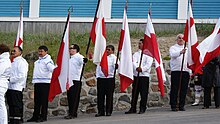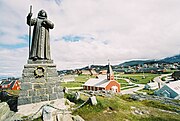
Greenland is a North American autonomous territory of the Kingdom of Denmark. It is the largest country within the Kingdom and one of three countries which form the Kingdom, the others being Denmark proper and the Faroe Islands; the citizens of all three countries are citizens of Denmark. As Greenland is one of the Overseas Countries and Territories of the European Union, citizens of Greenland are also granted European Union citizenship. The capital and largest city of Greenland is Nuuk. Greenland lies between the Arctic and Atlantic oceans, east of the Canadian Arctic Archipelago. It is the world's largest island, as well as the northernmost area of the world – Kaffeklubben Island off the northern coast is the world's northernmost undisputed point of land, and Cape Morris Jesup on the mainland was thought to be so until the 1960s.

This is a demography of the population of Greenland including population density, ethnicity, economic status, religious affiliations and other aspects of the population.

The history of Greenland is a history of life under extreme Arctic conditions: currently, an ice sheet covers about eighty percent of the island, restricting human activity largely to the coasts.

Nuuk is the capital of and most populous city in Greenland, an autonomous territory in the Kingdom of Denmark. Nuuk is the seat of government and the territory's largest cultural and economic center. The major cities from other countries closest to the capital are Iqaluit and St. John's in Canada and Reykjavík in Iceland. Nuuk contains a third of Greenland's population and its tallest building. Nuuk is also the seat of government for the Sermersooq municipality. In January 2023, it had a population of 19,604. Nuuk is considered a modernized city after the policy began in 1950.

Hans Poulsen Egede was a Dano-Norwegian Lutheran missionary who launched mission efforts to Greenland, which led him to be styled the Apostle of Greenland. He established a successful mission among the Inuit and is credited with revitalizing Dano-Norwegian interest in the island after contact had been broken for about 300 years. He founded Greenland's capital Godthåb, now known as Nuuk.
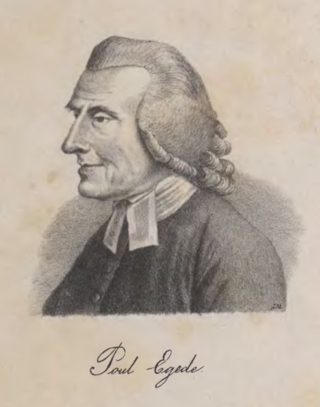
Paul or Poul Hansen Egede was a Dano-Norwegian theologian, missionary, and scholar who was principally concerned with the Lutheran mission among the Kalaallit people in Greenland that had been established by his father, Hans, in 1721.
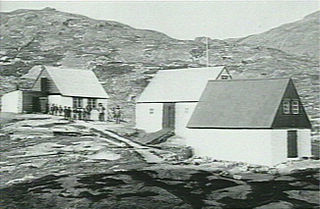
Kangeq or Kangek is a former settlement in the Sermersooq municipality in southwestern Greenland. It is located on the same island that formed the first Danish-Norwegian colony on Greenland between 1721 and 1728.
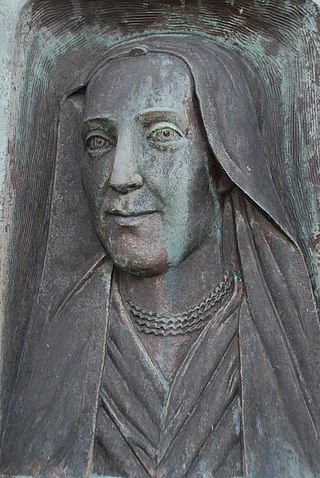
Gertrud Rask was the first wife of the Danish-Norwegian missionary to Greenland Hans Egede and was the mother of the missionary and translator Paul Egede.

Nuuk Cathedral or Church of Our Saviour is a wooden Lutheran cathedral in the Old Nuuk neighborhood of Nuuk, the capital of Greenland. It was established in 1849. The red building with its spire is a prominent site on the landscape. During National Day celebrations, large crowds usually gather around the church.

Dr. Hinrich Johannes Rink was a Danish geologist, one of the pioneers of glaciology, and the first accurate describer of the inland ice of Greenland. Rink, who first came to Greenland in 1848, spent 16 winters and 22 summers in the Arctic region, and became notable for Greenland's development. Becoming a Greenlandic scholar and administrator, he served as Royal Inspector of South Greenland and went on to become Director of the Royal Greenland Trading Department. With "Forstanderskaber", Rink introduced the first steps towards Greelandic home rule.
Hans Egede Saabye was a Danish priest and a missionary to Greenland.

Greenlandic independence is a political ambition of some political parties, advocacy groups, and individuals of Greenland, an autonomous territory within the Kingdom of Denmark, to become an independent sovereign state.
Major Claus Enevold Paarss was a Danish military officer and official. Retired from service, he was appointed governor of Greenland by King Frederick IV between 1728 and 1730.

Greenlandic people in Denmark are residents of Denmark with Greenlandic or Greenlandic Inuit heritage. According to StatBank Greenland, as of 2020, there were 16,780 people born in Greenland living in Denmark, a figure representing almost one third of the population of Greenland. According to a 2007 Danish government report, there were 18,563 Greenlandic people living in Denmark. The exact number is difficult to calculate because of the lack of differentiation between Greenlandic and Danish heritage in Danish government records and also due to the fact that the way in which people identify themselves is not always a reflection of their birthplace. As of 2018, there were 2,507 Greenlanders enrolled in education in Denmark.
Augustinus "Augo" Telef Nis Lynge was a Greenlandic politician, educator, poet, novelist and Kalaaleq nationalist who was the first Greenlandic representative in the Danish parliament and died during the sinking of the MS Hans Hedtoft.
Niels Rasch Egede was a Danish-Norwegian merchant and Lutheran missionary in Greenland.
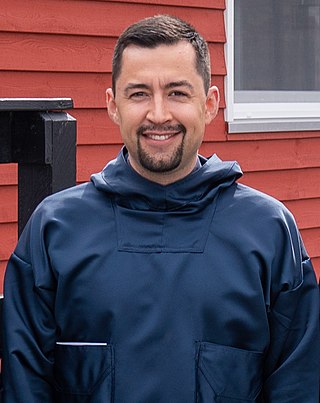
Múte Inequnaaluk Bourup Egede is a Greenlandic politician currently serving as the seventh prime minister of Greenland, a position he has held since April 2021. He has served as a member of the Inatsisartut, the parliament of Greenland, since 2015, and furthermore as chairman of the Inuit Ataqatigiit party since 2018.

Pele Broberg is a Greenlandic politician (Naleraq), entrepreneur and pilot. He became minister of foreign affairs, trade, climate and business in April 2021, but foreign affairs and climate were transferred to the premier of Greenland Múte Bourup Egede in September 2021 after a controversy. Broberg was minister for finance in 2018.


